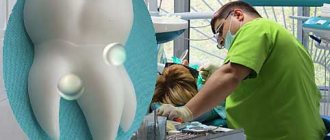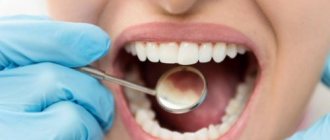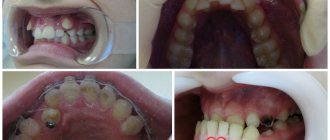Increased sensitivity of teeth (hyperesthesia) is a short-term occurrence of pain under the influence of temperature, chemical or mechanical irritating factors. Usually occurs when drinking cold water, sour, sweet, salty, or touching with a toothbrush. The intensity of pain varies from mild to unbearable.
According to WHO, every second person in the world suffers from hypersensitivity. In Russia it is about the same: 45–65% of adults aged 20–55 years. More often women make complaints.
A little anatomy
A tooth consists of a crown and root part, connected by a neck. The coronal part is covered with enamel, the root part is covered with cement. Beneath the enamel and cement there is dentin, a hard tissue. Inside there is soft tissue - the pulp; blood vessels and nerves pass through it.
Dentin is not sensitive, but consists of many tubules in which fluid circulates. The irritant causes fluid movement, which is detected by the nerve endings of the pulp. A person feels their reaction as pain.
Chronic periodontitis
Chronic periodontitis sometimes develops asymptomatically, or acute periodontitis can progress to this stage. Chronic periodontitis develops when the pulp dies, and favorable conditions are created in the tooth for the development of microorganisms. Sometimes chronic periodontitis can appear after a tooth injury.
Symptoms
- Changing the color of tooth enamel
- The presence of a fistula on the gum
- Painful sensations when chewing solid food
Chronic periodontitis can have many very serious complications: granuloma, root cyst, pathological fracture of the lower jaw, periapical abscess, phlegmon and others.
Tooth sensitivity: causes
- Demineralization of enamel. It becomes more loose due to the leaching of calcium, phosphorus, and other trace elements.
- Thinning of enamel. As a result of increased abrasion due to malocclusion and the occurrence of wedge-shaped defects.
- Untreated caries or violation of the marginal seal of the filling.
- Exposure of roots as a result of injury, metabolic-dystrophic process or inflammation of the gums.
- Changes in the pH of saliva due to the consumption of certain drinks, foods, and medications. A pH of less than 5.5 is considered dangerous.
- Some diseases accompanied by gastroesophageal reflux and endocrine disorders.
- Vitamin deficiency, exposure to radiation, work in hazardous industries, living in a region with an unfavorable environmental situation.
- Smoking.
More often than not, several reasons are discovered at once. The enamel becomes thinner, loses strength, and cannot protect dentin from irritants. The result is pain.
Thinning enamel
Tooth enamel can become thinner for a variety of reasons, such as:
- improper bleaching or poor-quality professional cleaning;
- using brushes that are too hard;
- using pastes with abrasives that expose the enamel to chemical and mechanical stress;
- vitamin deficiency (the pain in this case is characterized by an aching, twitching character and manifests itself during cleaning, rinsing the mouth, eating and drinking).
Provoking factors
Hyperesthesia does not appear immediately. There are several factors that you need to pay attention to in order to eliminate them in time. Don't wait for discomfort to appear. It is better to initially develop healthy habits that will help you maintain your health so that you never experience acute dental pain. Sensitivity increases when any of the factors listed below are present.
- Insufficient oral hygiene. Soft plaque is an accumulation of microbes that eat food microparticles stuck in crevices, releasing organic acids that dissolve enamel minerals. Externally, the dental unit looks intact, but the density of the enamel is significantly reduced. Its demineralization occurs. The first alarm bell is increased sensitivity, then caries develops.
- Consumption of certain foods. Juices, wine, sweet soda, fruits, candies, and other sweets contain phosphoric and other acids that negatively affect the strength of enamel.
- Constant use of aggressive whitening pastes containing abrasive and chemical components.
- Ultrasonic cleaning. Under a dense coating, the enamel becomes thinner and becomes loose. After professional cleaning, it is exposed, its sensitivity increases sharply. Usually, dentists, taking this point into account, use strengthening pastes at the end of the procedure for the preventive treatment of tooth sensitivity.
Diagnostics
When diagnosing dentin hypersensitivity, it should be borne in mind that it is often a symptom of a disease. Therefore, when a patient approaches, the dentist begins treatment with a survey, during which he receives answers to the following questions:
- duration and nature of the pain syndrome;
- number of units with dentin sensitivity;
- localization of increased susceptibility;
- characteristics of stimuli that cause pain.
After the examination, the patient is required to undergo probing of sensitive areas and other diagnostic tests (thermal, electrical, osmotic, evaporative), as well as percussion (tapping on individual areas of the tooth). At the same time, they find out whether the element is sensitive when biting, identify microcracks in the enamel, damage inside and around the filling, malocclusion, and signs of bruxism.
In addition, diagnostics are carried out using hardware methods and “hidden” carious lesions and periapical changes are identified if they are present.
Much attention is paid to determining the level of pain and the degree of tooth sensitivity:
- no pain;
- mild discomfort;
- medium intensity;
- severe pain or unbearable.
The patient's pain reaction may occur to a greater extent to thermal stimuli (cold, heat), tactile (tactile), evaporative (air), electrical or osmotic (solutions of weak acids).
Dentists note that the reaction most often occurs to cold, brushing teeth, heat and sweets.
The more dentin is exposed due to dental diseases and other factors contributing to enamel loss, the higher the degree of hyperesthesia. This is explained by the fact that in completely exposed dentin there are more dilated tubules with open holes.
Types of hypersensitivity
If sensitivity is increased on one or more teeth, it is called limited. If for everyone - generalized.
Table 1. Types of hyperesthesia
| № | View | Reaction |
| 1. | Light | for cold, hot |
| 2. | Average | as with 1st degree plus for sour, sweet, salty |
| 3. | Expressed | as in grade 2 plus mechanical irritants (when brushing teeth, eating) |
Sensitivity of teeth. Stages of treatment
- Eliminate the cause of hyperesthesia: get rid of plaque, deposits, stones, caries, wedge-shaped defects.
- Carry out professional oral hygiene.
- Strengthen the enamel with calcium and fluoride.
- Teach the patient how to use a toothbrush and floss correctly.
- Choose suitable dental care products: toothpaste, mouthwash.
Table 2. Tooth sensitivity: causes and how to treat
| № | Cause | What to do |
| 1. | Soft coating. | Careful hygiene with home remedies. |
| 2. | Hard coating. | Professional hygiene in dentistry. |
| 3. | Caries in the white spot stage. | Deep fluoridation, remineralization. |
| 4. | Caries, pulpitis, periodontitis. | Dental treatment. |
| 5. | Exposure of the cervical part, wedge-shaped defect. | |
| 6. | Malocclusion. | Orthodontic therapy. |
Elimination of tooth sensitivity
Using ultrasound, the doctor removes soft and hard deposits from the teeth. After removing plaque, teeth become more sensitive for a short time, so remineralization or deep fluoridation is immediately carried out. During remineralization, the enamel is treated with active compounds of calcium and phosphates. Deep fluoridation – coating with sodium fluoride. Both procedures significantly strengthen the enamel's resistance to irritants.
The doctor uses agents that reduce the movement of fluid in the dentinal tubules. It “seals” them using desensitizers or reduces their volume through remineralization. Protecting exposed dentin reduces the force of transmission of the irritant impulse from the enamel to the nerve.
What is periostitis and how does it develop?
Periostitis (flux) is an inflammation of the periosteum - the tissue covering the bones of the upper and lower jaw. The inflammatory process in this case usually proceeds very intensely: a large amount of pus is formed, the patient’s well-being is disturbed, and a significant rise in body temperature may be observed.
- The pain in this case is intense and can be bursting, throbbing or tearing.
- Upon examination, the gums of the diseased tooth are inflamed, swollen, and painful when pressed. The swelling extends to the cheek and can be so severe that the face becomes asymmetrical.
- On the mucous membrane of the cheek in the immediate vicinity of the diseased tooth there may be a swelling with a hole for the release of pus. If there are no ways for the outflow of pus to the outside, then it can break into the soft tissues of the cheek and neck, posing a threat to the health and life of the patient.
Basic points of proper hygiene
Use a synthetic, medium-hard or soft brush. Change it every three months.
The toothpaste should be suitable for very sensitive teeth. Typically, such products contain hydroxyapatite, strontium chloride, fluorides, potassium nitrate, or a combination of calcium carbonate and arginine.
Take enough paste. For children under 3 years old - the size of a grain of rice, from 3 to 14 years old - the size of a pea, for adults you need to squeeze out about one centimeter.
Brush your teeth for 2 minutes: 30 seconds on each surface, top and bottom. Monitor time using an hourglass or mobile phone timer. Electric toothbrushes emit a short beep every 30 seconds and a long beep every 2 minutes from the start of brushing.
Cleaning sequence
- Using sweeping movements, clean the outer and then the inner surfaces of the bottom row. Move from molars to incisors. Then do the same on the top row. Hold the brush at a 45-degree angle and do not use a sawing motion. This leads to damage to the enamel.
- Brush chewing surfaces with small circular movements.
- Close your jaws and walk along your gums in a circular motion.
- Brush your tongue using a leisurely four to five strokes from root to tip.
- Treat the interdental spaces with dental floss.
- Rinse your mouth.
It is more effective to clean with an electric brush or irrigator. The quality of hygiene increases 3–4 times. Hyperesthesia can be dealt with faster.
Is it possible to strengthen sensitive teeth at home?
Yes. If you can’t get to the dentist, you can try to help yourself. There are several remedies that can solve the problem of hyperesthesia at home.
Table 3. Popular products for home use
| № | Name | Mechanism of action | Age category |
| 1. | ROCS Medical Minerals, GC Tooth Mousse | Remineralizing gels | Adults and children |
| 2. | Colgate Duraphat 2800 ppm | Fluoridating paste | 10–15 years |
| 3. | Colgate Duraphat 5000 ppm | From 16 years old | |
| 4. | ELMEX junior | Fluoridating paste | 6–12 years |
| 5. | ELMEX | From 13 years old | |
| 6. | LACALUT Extra Sensitive | Paste that reduces tooth sensitivity | For adults |
| 7. | Colgate Sensitive Pro-Relief | ||
| 8. | PRESIDENT Sensitive | ||
| 9. | LACALUT Sensitive, 300 ml | Rinse for sensitive enamel | From 15 years old |
Algorithm of actions for hyperesthesia
- Adjust your diet. Avoid completely or significantly reduce the consumption of foods and drinks containing acids and sugar. Especially fruit and berry juices, wine, candies. Eat more green vegetables, fiber-rich foods, and whole grains.
- Change your toothpaste. Never use bleach. Choose from those labeled "Sensitive".
- Check if you are practicing proper oral hygiene. If it's wrong, correct it.
- Make an appointment with your dentist to find out the type of tooth sensitivity, find out the cause and get treatment.
- Visit the dentist twice a year, even if nothing hurts.
Toothache caused by hot and cold foods
If your teeth respond with a painful reaction when eating such dishes, this means that the problem lies in the enamel of the teeth. When the enamel is healthy, the tooth structure is reliably protected from sudden temperature changes. If your teeth respond with pain when you eat, you should immediately visit a dentist to identify the cause. Here are a few reasons that cause such pain:
- Tissue inflammation has occurred;
- The structure in the enamel is damaged;
- Non-carious lesions;
- Cracks have appeared;
- Due to severe stress, the enamel has become thinner.
By the way, it happens that such pains are caused by the endocrine system or they may be caused by a stomach disease. It is necessary to reconsider your eating habits. It is necessary to reduce the consumption of foods with too high and low temperatures, and also be careful when drinking sour juices. To do this, you should use a straw.
Treatment of hyperesthesia in the “Family Doctor”
If hyperesthesia occurs, make an appointment with a dentist by calling the contact center in Moscow +7 (495) 775 75 66 or using the online appointment form. Our clinic has been operating for more than 26 years. Experienced doctors help patients cope with pressing problems, including hypersensitivity.
The doctor will find out the cause of tooth sensitivity and provide effective treatment. In most cases, it is enough to select suitable oral care products and carry out proper hygiene procedures. In more complex situations, full treatment is used, and if necessary, surgical treatment.
The clinic takes a gentle approach to patients. All procedures are accompanied by adequate pain relief, which eliminates the occurrence of discomfort and pain. Increased sensitivity of teeth is not just a feature of them. This is the beginning of a disease that must be cured. And it's better to do it as quickly as possible.
Symptoms
The main symptom of tooth enamel hyperesthesia is acute short-term pain. Usually the patient complains that the tooth feels cold, sweet, hot, sour, and begins to hurt. In this case, the pain is short-lived; literally after a few seconds the pain subsides and the tooth stops hurting. The intensity of toothache can range from mild discomfort to very severe throbbing pain. In some particularly difficult cases, patients cannot even breathe in cold air and only take warm, neutral-tasting food.
Typically, pain during hyperesthesia is a constant symptom, but sometimes temporary periods of remission are observed when the teeth do not respond to stimuli at all or the intensity of pain is significantly reduced.











